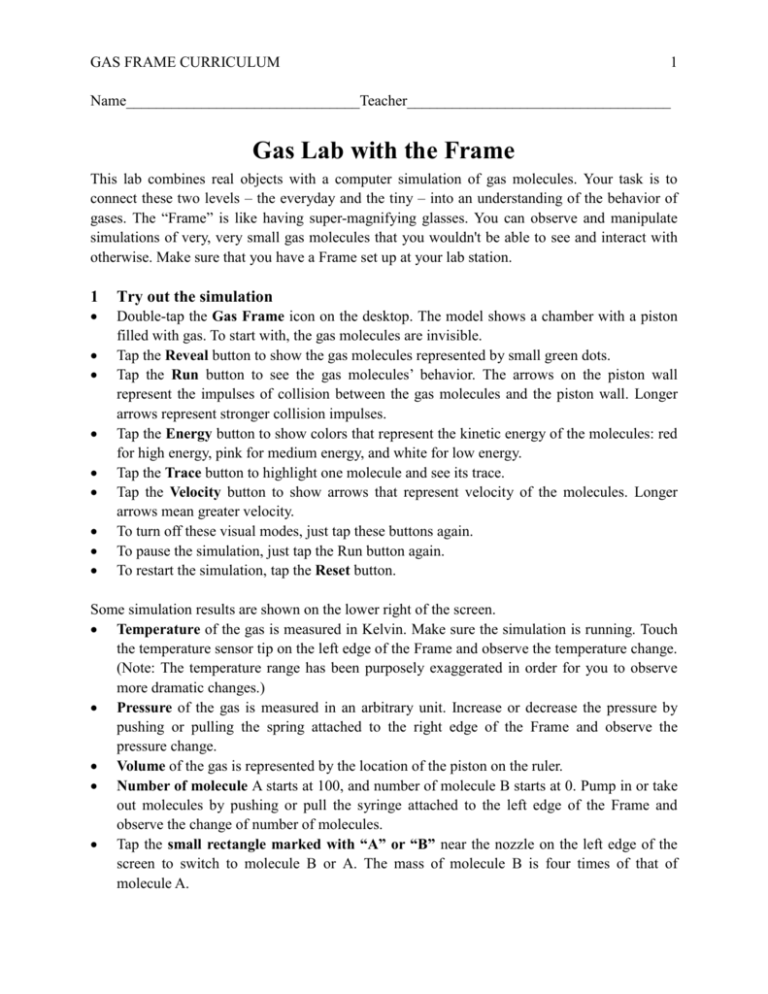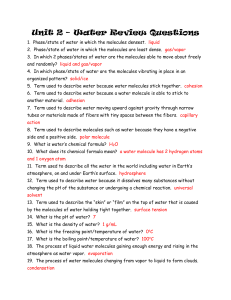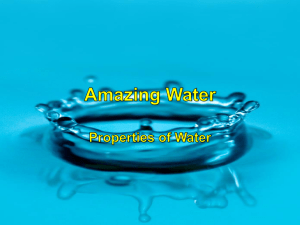Behavior of an individual molecule
advertisement

GAS FRAME CURRICULUM 1 Name_______________________________Teacher___________________________________ Gas Lab with the Frame This lab combines real objects with a computer simulation of gas molecules. Your task is to connect these two levels – the everyday and the tiny – into an understanding of the behavior of gases. The “Frame” is like having super-magnifying glasses. You can observe and manipulate simulations of very, very small gas molecules that you wouldn't be able to see and interact with otherwise. Make sure that you have a Frame set up at your lab station. 1 Try out the simulation Double-tap the Gas Frame icon on the desktop. The model shows a chamber with a piston filled with gas. To start with, the gas molecules are invisible. Tap the Reveal button to show the gas molecules represented by small green dots. Tap the Run button to see the gas molecules’ behavior. The arrows on the piston wall represent the impulses of collision between the gas molecules and the piston wall. Longer arrows represent stronger collision impulses. Tap the Energy button to show colors that represent the kinetic energy of the molecules: red for high energy, pink for medium energy, and white for low energy. Tap the Trace button to highlight one molecule and see its trace. Tap the Velocity button to show arrows that represent velocity of the molecules. Longer arrows mean greater velocity. To turn off these visual modes, just tap these buttons again. To pause the simulation, just tap the Run button again. To restart the simulation, tap the Reset button. Some simulation results are shown on the lower right of the screen. Temperature of the gas is measured in Kelvin. Make sure the simulation is running. Touch the temperature sensor tip on the left edge of the Frame and observe the temperature change. (Note: The temperature range has been purposely exaggerated in order for you to observe more dramatic changes.) Pressure of the gas is measured in an arbitrary unit. Increase or decrease the pressure by pushing or pulling the spring attached to the right edge of the Frame and observe the pressure change. Volume of the gas is represented by the location of the piston on the ruler. Number of molecule A starts at 100, and number of molecule B starts at 0. Pump in or take out molecules by pushing or pull the syringe attached to the left edge of the Frame and observe the change of number of molecules. Tap the small rectangle marked with “A” or “B” near the nozzle on the left edge of the screen to switch to molecule B or A. The mass of molecule B is four times of that of molecule A. GAS FRAME CURRICULUM 2 2 Behavior of an individual molecule In this activity, you will investigate the behavior of an individual molecule. Reset and run the simulation, reveal the molecules, and trace one molecule. Observe this one molecule carefully and answer the following questions. 2.1 What happens when the molecule collides with the piston wall? ______________________________________________________________________________ ______________________________________________________________________________ ______________________________________________________________________________ __________________________________________________________________________ 2.2 What happen when the molecule collides with another molecule? ______________________________________________________________________________ ______________________________________________________________________________ ______________________________________________________________________________ __________________________________________________________________________ 2.3 Why is the molecule’s speed always changing? ______________________________________________________________________________ ______________________________________________________________________________ ______________________________________________________________________________ __________________________________________________________________________ 2.4 Why is the molecule’s kinetic energy always changing? ______________________________________________________________________________ ______________________________________________________________________________ ______________________________________________________________________________ __________________________________________________________________________ GAS FRAME CURRICULUM 3 3 Temperature In this activity, you will investigate the nature of temperature of a gas. Temperature (T) is a measure of the average kinetic energy of the molecules. An individual molecule’s kinetic energy (k) is proportional its mass (m) and its velocity squared (v2). The formula for kinetic energy is: 1 𝑘 = 𝑚𝑣 2 2 3.1 Reset the simulation and DON’T run it yet. Answer this question first and you will have a chance to revise your answer later. The picture below shows gas molecules at room temperature. The arrows represent molecules’ speed and direction. Draw how you think the molecules would look in a cold room and a hot room. Room temperature Cold room Hot room 3.2 Run the simulation and reveal the molecules. Change the temperature of the Frame by touching hot or cold jars next to the temperature sensor (ask teacher for hot water and ice cubes). When you increase or decrease the temperature, do all molecules have the same speed? ☐YES ☐NO 3.3 When you decrease the temperature, do all the molecules A. spread out more. B. gather together in the middle. C. fill the chamber the same as before. 3.4 What happens to the average speed of the molecules when you increase or decrease temperature? ______________________________________________________________________________ ______________________________________________________________________________ ______________________________________________________________________________ __________________________________________________________________________ GAS FRAME CURRICULUM 4 3.5 Based on your observation, would you change your drawing of molecules in a hotter or colder room? ☐YES ☐NO Explain why or why not and provide new drawings if needed. ______________________ ______________________ ______________________ ______________________ ______________________ ______________________ Cold room 4 Hot room Pressure In this activity, you will investigate the nature of pressure of a gas. When a molecule collides with the piston wall, it exerts a force on it. The total force on the piston wall is the sum of forces exerted by individual molecules. Pressure (p) is defined as the force (F) on a given surface (A). 𝐹 𝑝= 𝐴 4.1 Reset and run the simulation. DON’T reveal the molecules yet. Follow the instruction and answer this question first. You will have a chance to revise your answer later. Make sure the gas temperature is constant. You need to move the hot or cold jar away from the Frame and wait until its temperature returns to room temperature (around 300 Kelvin). Add 100 gas molecules into the chamber while keeping the piston at its original position. As the number of molecules increases, it becomes harder and harder to control the piston. What do you think happens inside the chamber that makes the gas pressure increase? Please draw to help you explain. ______________________________________________________________________________ ______________________________________________________________________________ __________________________________________________________________________ 100 molecules Before adding molecules 200 molecules After adding molecules GAS FRAME CURRICULUM 5 4.2 Now, reset and run the Frame and repeat what you did in 4.1 with the gas molecules revealed, and observe what happen that makes the gas pressure increase. Was your answer correct? Describe the evidence that either support or revise your answer. Provide new drawings if needed. ______________________________________________________________________________ ______________________________________________________________________________ ______________________________________________________________________________ ______________________________________________________________________________ _________________________________________________________________________ 100 molecules Before adding molecules 5 200 molecules After adding molecules Relationship between pressure and volume at constant temperature The kinetic molecular theory of an ideal gas predicts the following relationship: 𝑃𝑉 = 𝑛𝑅𝑇 Where P is pressure, V is volume, n is number of molecules, R is a constant, and T is temperature. As you explore the model, see if this relationship holds up for this model of an ideal gas. In this activity, you will investigate the relationship between pressure and volume of a certain amount of gas at constant temperature. You will collect data using the Frame, display your data in a line graph, draw a conclusion based on your data, and explain your finding based on what you know about behavior of molecules. 5.1 Data collection: First, reset and run the Frame. To find out the relationship between volume and pressure, you need to control other variables that may confound your results. 1. Make sure that the chamber only has a single type of molecule. 2. Keep a fixed number of molecules in the chamber—no molecules being pumped in or sucked out. 3. Keep the temperature constant. Change volume by pushing or pulling the spring and then wait for at least 10 seconds while holding the spring in the new position for the simulation to reach equilibrium. Because the piston always fluctuates, you should record an average value. Repeat this procedure for at least five volume values. Record your data below and graph the data to determine the relationship. GAS FRAME CURRICULUM Trial # 6 Volume Pressure 1 2 3 4 5 5.2 Display your data in a line graph below. Use the average values from each trial. 25 Pressure 20 15 10 5 0 5 10 15 Volume 20 25 GAS FRAME CURRICULUM 7 5.3 Based on your data, what is your conclusion about the relationship between pressure and volume at constant temperature? Does your finding match what would be expected for an ideal gas where PV = nRT? ______________________________________________________________________________ ____________________________________________________________________________ 5.4 Explain why the relationship between pressure and volume exists based on what you know about the behavior of molecules. Draw to help you explain. ______________________________________________________________________________ ______________________________________________________________________________ ______________________________________________________________________________ __________________________________________________________________________ Gas Before pushing the piston 6 Gas After pushing the piston Relationship between temperature and volume at constant pressure In this activity, you will investigate the relationship between temperature and volume of a certain amount of gas at constant pressure. This time, you will design your own experiment. Then you will collect data, display your data in a line graph, draw a conclusion based on your data, and explain your finding based on what you know about the behavior of molecules. 6.1 Create a method you will use for this investigation and describe it below. You may use the method described in 5.1 as a reference. Ask teacher for help if you need (Hint: you may use four different temperatures: room temperature, temperature of your fingers, temperature of the cold jar, and temperature of the hot jar.) ______________________________________________________________________________ ______________________________________________________________________________ ______________________________________________________________________________ ______________________________________________________________________________ _________________________________________________________________________ GAS FRAME CURRICULUM 8 6.2 Record your data in the table below. Trial # Temperature Volume 1 2 3 4 6.3 Display your data in a line graph below. Use the average values from each trial. 25 Volume 20 15 10 5 200 250 300 350 400 Temperature 450 500 GAS FRAME CURRICULUM 9 6.4 Based on your data, what is your conclusion about the relationship between temperature and volume at constant pressure? Does your finding match what would be expected for an ideal gas where PV = nRT? ______________________________________________________________________________ ______________________________________________________________________________ ______________________________________________________________________________ ______________________________________________________________________________ ______________________________________________________________________________ ________________________________________________________________________ 6.5 Explain why the relationship between temperature and volume exists based on what you know about molecules’ behavior. Draw to help you explain. ______________________________________________________________________________ ______________________________________________________________________________ ______________________________________________________________________________ ______________________________________________________________________________ ______________________________________________________________________________ ________________________________________________________________________ Gas Gas Before being heated After being heated GAS FRAME CURRICULUM 10 7 Does the mass of molecules affect gas pressure at constant temperature and constant volume? In this activity, you will investigate whether the mass of molecules affects gas pressure at constant temperature and constant volume. This time, you will first make a prediction based on what you have learned so far. Then, you will design your own experiment, collect data, draw a conclusion based on your data, and explain your finding based on what you know about the behavior of molecules. 7.1 Based on what you have learned so far, do you think the mass of molecules (heavy molecules versus light molecules) affects gas pressure at constant temperature and constant volume? A. The heavier gas molecules are, the higher gas pressure is. B. The heavier gas molecules are, the lower gas pressure is. C. The mass of molecules does not affect gas pressure. D. It is impossible to know how the mass of molecules affects gas pressure. Explain your prediction: ______________________________________________________________________________ ______________________________________________________________________________ ______________________________________________________________________________ ______________________________________________________________________________ ______________________________________________________________________________ ________________________________________________________________________ 7.2 Create a method you will use for this investigation and describe it below. Remember, in the simulation, the mass of molecule B is four times of that of molecule A. Ask teacher for help if needed. ______________________________________________________________________________ ______________________________________________________________________________ ______________________________________________________________________________ ______________________________________________________________________________ ______________________________________________________________________________ ________________________________________________________________________ GAS FRAME CURRICULUM 11 7.3 Record your data below. ______________________________________________________________________________ ______________________________________________________________________________ ______________________________________________________________________________ ______________________________________________________________________________ ______________________________________________________________________________ ________________________________________________________________________ 7.4 Based on your data, what is your conclusion about the effect of mass of molecules on gas pressure at constant temperature and constant volume? Does your finding match what would be expected for an ideal gas where PV = nRT? ______________________________________________________________________________ ______________________________________________________________________________ ______________________________________________________________________________ ______________________________________________________________________________ _________________________________________________________________________ 7.5 Explain why or why not the mass of molecules affect the gas pressure at constant temperature and constant volume. Draw to help you explain. ______________________________________________________________________________ ______________________________________________________________________________ ______________________________________________________________________________ ______________________________________________________________________________ _________________________________________________________________________ Gas Gas Heavy molecules Light molecules GAS FRAME CURRICULUM 8 12 Partial pressure In this activity, you will investigate the pressure of a mixture of gases. In a mixture of gases, each component gas has a partial pressure, which is the pressure that this component gas would exert if it were alone in the container. Students from another school concluded from their experiments that the total pressure of the gas mixture is the sum of the partial pressures of all component gases (as shown in the figure below). You will first evaluate this conclusion based on what you have learned so far and explain your evaluation. Then, you will design your own experiment, collect data, draw a conclusion based on your data, and explain your finding based on what you know about the behavior of molecules. pA = pressure when type-A molecules are in the chamber pB = pressure when type-B molecules are in the chamber ptotal = pA + pB 8.1 Do you think you will reach the same conclusion about total pressure and partial pressure? Why or why not? ______________________________________________________________________________ ______________________________________________________________________________ ______________________________________________________________________________ __________________________________________________________________________ 8.2 Create a method you will use to test the relationship between partial pressure and total pressure and describe it below. Ask teacher for help if you need. ______________________________________________________________________________ ______________________________________________________________________________ ______________________________________________________________________________ ______________________________________________________________________________ ______________________________________________________________________________ ________________________________________________________________________ GAS FRAME CURRICULUM 13 8.3 Record your data below. ______________________________________________________________________________ ______________________________________________________________________________ ______________________________________________________________________________ ______________________________________________________________________________ ______________________________________________________________________________ ________________________________________________________________________ 8.4 Based on your data, what is your conclusion about relationship between partial pressure and total pressure? ______________________________________________________________________________ ______________________________________________________________________________ ______________________________________________________________________________ ______________________________________________________________________________ ______________________________________________________________________________ ______________________________________________________________________________ _______________________________________________________________________ 8.5 Explain your conclusion based on what you know about the behavior of gas molecules. ______________________________________________________________________________ ______________________________________________________________________________ ______________________________________________________________________________ ______________________________________________________________________________ ______________________________________________________________________________ ______________________________________________________________________________ _______________________________________________________________________








